Introduction
Introduction of the Sapphire R9 285 2GB Dual-X OC
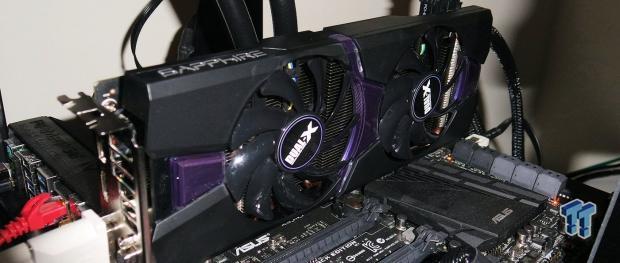
Sitting here writing the first sentence of this Sapphire R9 285 2GB Dual-X OC video card review, I find myself already annoyed at AMD. This is because while I'm only just starting to write the review now, I've already tested the card and have come to a conclusion on it in my head. I found myself having a conversation with an AMD partner, which was a conversation I've had with them so many times before. What are AMD doing?
I don't want you to now think that this is a bad video card and you should stop reading. I don't think I've ever really written my final thoughts about a product in an introduction, but the last thing I want you to do is stop reading and give up on the card. The Sapphire R9 285 Dual-X OC is a good card and you'll see that as we move forward today. As for my annoyance with AMD, that's also something I'll cover when I wrap things up.
For now let's talk about what's going on with the new model that is launching today. Because AMD thought that everyone wasn't busy enough with a new Intel platform that brought with it new CPUs, motherboards and RAM modules, they thought they'd throw a spanner into the works and make everyone else work a little bit harder then they need to.
The second I heard about this model, I this instant feeling that it would never get off the ground. If we've learnt anything over the years, it would be that as soon as AMD release a model that ends in the number "5" or has a "XT" label on it, it's destined to not get off the ground - especially when AMD have got a series that is as tight packed as they do right now.
Get ready to be confused. The R9 285 2GB is designed to sit above the $199 R9 270X, but below the $299 R9 280X. It sits smack bang in the middle at $249. Of course that's not going to confuse anyone..... Outside of that, AMD weren't happy with how we reviewed the R9 280 originally. We called them out for setting the model at a terrible price point and when they finally dropped the card down to a more aggressive price point, they wanted us to look at the model again. We did... four of them actually!
That's fine. I don't mind it at all. I like to review video cards and the price drop they offered on the cards was great and made the model look a whole lot more attractive. Awesome! But looking below. Where does the R9 280 sit?

A model that AMD all of a sudden wanted to suddenly re-promote isn't even in the main PowerPoint when it comes to covering the new R9 285 2GB. Priced anywhere from $199 - $278, though, why would it? The R9 280 3GB is a good model and we really liked the performance that was offered from the model. I feel like I could honestly go on and on and on here. Instead of that, though, let's move forward and take a look at the card we have here. Today we're looking at the Sapphire R9 285 2GB OC. It came direct from AMD and didn't include a package, so we're going to simply be moving on from here to the card.
Video Card Details and Specifications
Close up with the Sapphire R9 285 2GB Dual-X OC
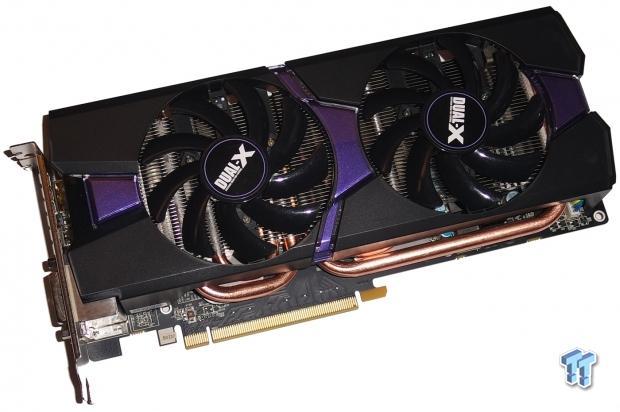
Pulling the card out of the box, we can see the Dual-X cooling solution. This isn't anything new from Sapphire. What is new, though, is the purple highlights, which look awesome. Sapphire has really gone outside of the box recently when it comes to adding color to their cards. The purple looks great and the blue that we see on the Vapor-X cards looks really awesome.
Outside of the purple highlights and two fans, though, you can see a massive heat sink underneath and a couple of copper heat pipes coming out the bottom of the card. Everything is sitting on a very sexy looking black PCB which kind of just finishes off the look in a very positive way.


Taking a quick spin around the card, you can see that power for the card comes in the form of two 6-Pin PCIe power connectors. Moving closer to the front, you can see we've got a switch that lets us swap between two BIOSes that are installed. What we don't have is CrossFire bridges. This isn't because it's not supported, but because AMD has included the latest CrossFire technology which is seen in the R9 290 series cards. That means that you're able to CrossFire this card with another R9 285 2GB without a CrossFire cable.

Heading over to the I/O side, you can see we've got a pair of DVI connectors that sit alongside a HDMI and DisplayPort connector to round things off. This is a fairly standard I/O setup.
Specifications
Taking a look below, we can see where the R9 285 sits when compared to other R9 28X cards. When it comes to the specifications, you can see we're pretty much dealing with an R9 280 with a 256-bit bus instead of the 384-bit bus. Stream Processors and Texture units are identical. Because of this, overall compute performance is nearly identical.
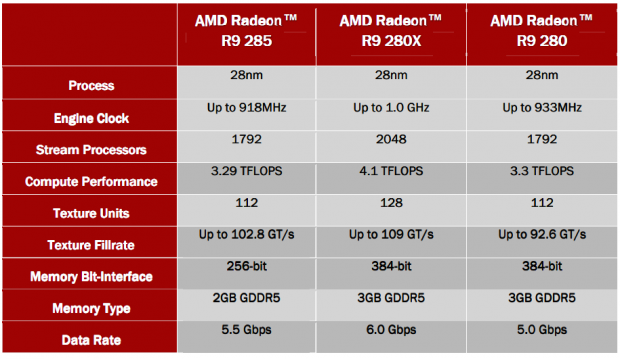
When it comes to clock speeds, the reference core clock is up to 918MHz, while the 2GB of GDDR5 carries a 5500MHz QDR memory clock speed. Looking below, you can see that Sapphire has bumped both of these numbers up slightly on their Dual-X version of the card.
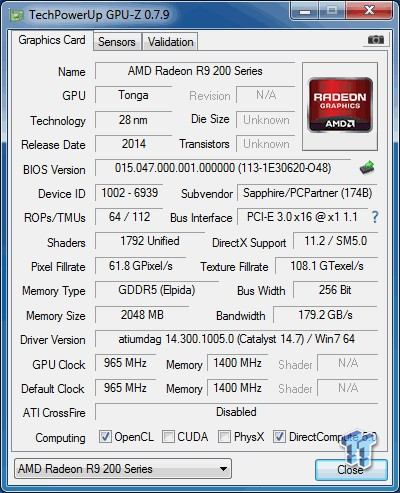
The core has been increased to 965MHz, while the 2GB of GDDR5 has been bumped ever so slightly to 1400MHz, which translates to 5600MHz QDR. With AMD not really pushing the reference model, this is likely going to be one of those cards that most people will buy overclocked versions of.
Test System Setup & FPS Numbers Explained
Test System Setup

We would like to thank the following companies for supplying and supporting us with our test system hardware and equipment: Intel, ASUS and Corsair.
After going through the specifications, I find myself sitting here still a little confused with how exactly this model sits in the market. The problem is if you break everything down, the card should sit between the R9 270X and the R9 280 3GB. The specifications of the R9 280 3GB and R9 285 2GB are so close, though, that it's going to be extremely close when it comes down to performance - especially when you include out of the box overclocks into the mix.
In the end, though, you should be ultimately ignoring the specifications of the card. It really comes down to price which decides where the model sits. The AMD MSRP list, which doesn't include the R9 280 3GB, says that the new $249 R9 285 2GB sits between the $199 R9 270X and $299 R9 280X. The specs say the same thing, except for the fact that when you look closely, the R9 285 and R9 280 are practically on top of each other with the R9 280 coming out on top.
The issue is the GIGABYTE R9 280 TURBOFORCE 3GB with its really strong 1072MHz out of the box core clock can be had $219.99. Saying that, the R9 280 3GB is a rebadged HD 7950 3GB. That's fine because the HD 7950 3GB was a great card, but it doesn't carry with it some of those newer features that are seen on the true R9 cards. Looking below sums up what the R9 285 2GB ultimately is.
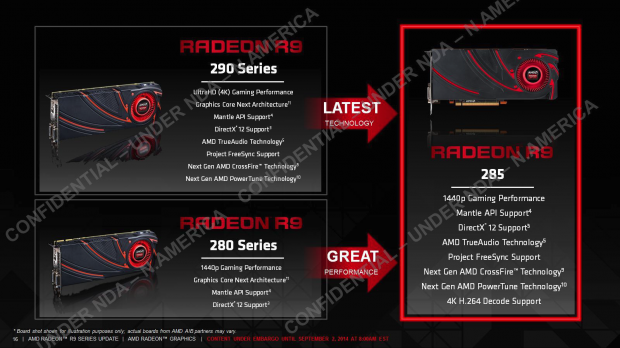
You can see it's the power of the R9 280 Series with the technology of the R9 290 Series. Ok that sounds all very cool, but in the end, what do gamers care about most? Performance! They want to see the numbers that can justify the associated price tag. So the question is, with a price tag that is higher than the R9 280X 3GB, yet a spec that looks lower, is it a video card to buy?
Well, that's what we'll find out today as we compare the Sapphire R9 285 2GB Dual-X OC against the HIS R7 260X iCooler 2GB, HIS R9 270X IceQ X2 Turbo Boost 2GB OC, GIGABYTE R9 280 WINDFORCE 3GB OC, Sapphire R9 280X 3GB Vapor-X OC, HIS R9 290 4GB IceQ X2 Turbo, ASUS GTX 750 Ti 2GB OC, MSI GTX 760 MINI-ITX Gaming, NVIDIA GTX 770 2GB and ASUS GTX 780 ROG Poseidon Platinum 3GB OC in what looks to be one of the most confusing mid-range video card battles we've seen in a long time.
While we've talked a whole lot about how the card sits in the AMD line up, before we move into the benchmarking, we should quickly cover where it compares from an NVIDIA stand point. AMD says the model goes directly up against the GTX 760 2GB. Looking at the price of that card, we'd say it's pretty spot on. So let's see just what happens when we throw all these video cards into the testbed and benchmark them.
The FPS Numbers Explained
When we benchmark our video cards and look at the graphs, we aim to get to a certain level of FPS which we consider playable. While many may argue that the human eye can't see over 24 FPS or 30 FPS, any true gamer will tell you that as we climb higher in Frames Per Seconds (FPS), the overall gameplay feels smoother. There are three numbers we're looking out for when it comes to our benchmarks.
30 FPS - It's the minimum number we aim for when it comes to games. If you're not dropping below 30 FPS during games, you're going to have a nice and smooth gaming experience. The ideal situation is that even in a heavy fire fight, the minimum stays above 30 FPS making sure that you can continue to aim easily or turn the corner with no dramas.
60 FPS - It's the average we look for when we don't have a minimum coming at us. If we're getting an average of 60 FPS, we should have a minimum of 30 FPS or better and as mentioned above, it means we've got some smooth game play happening.
120 FPS - The new number that we've been hunting down over recent months. If you're the owner of a 120 Hz monitor, to get the most out of it you want to get around the 120 FPS mark. Moving from 60 FPS / 60 Hz to 120 FPS / 120 Hz brings with it a certain fluidity that can't really be explained, but instead has to be experienced. Of course, if you're buying a 120 Hz monitor to take advantage of 3D, an average of 120 FPS in our benchmark means that in 3D you will have an average of 60 FPS, which again means you should expect some smooth gameplay.
Why are some graphs incomplete?
Adding new game benchmarks is a long, tedious and time consuming task as every video card has to be re-tested in those new benchmarks. Because of that reason we have always just evaluated our benchmark line up every six months. To stay up to date and current with the latest benchmarks and games available, we've changed our approach to adding new benchmarks.
Our benchmark line up will progress and be updated as newer more intensive games with benchmarks comes to light. While this will mean that initially you may only see a single video card in those particular graphs, as the weeks go on and we test more and more video cards, the results will grow quickly. This will help keep our benchmark line up as up to date as possible as we introduce and remove games on a constant basis.
Benchmarks - 3DMark
3DMark 11
Version and / or Patch Used: 1.1
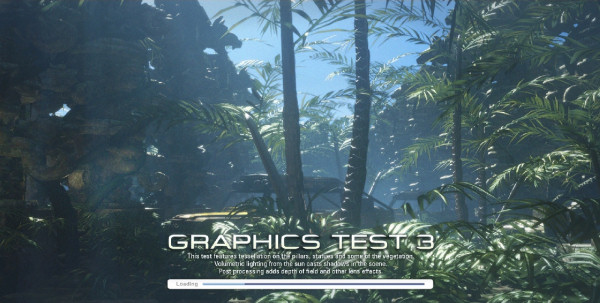
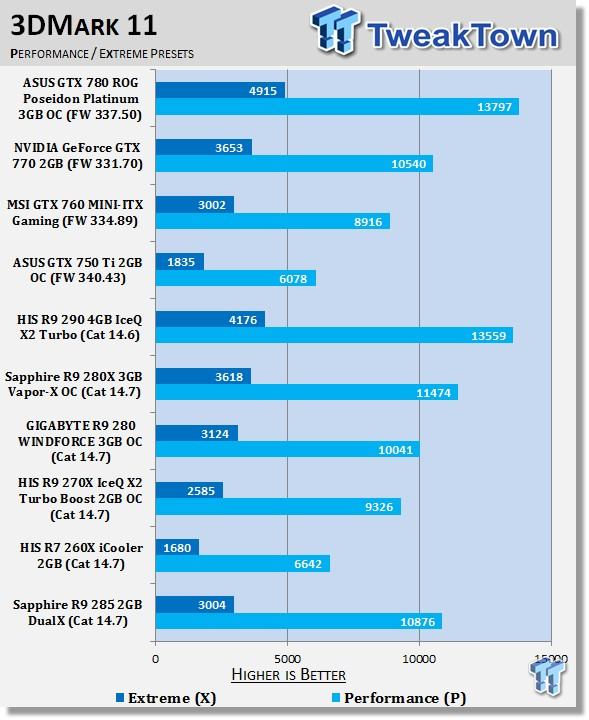
Out the gate, we've got a great start for the new Sapphire R9 285 2GB Dual-X OC. You can see against the GTX 760 2GB, it's got no problem coming out ahead, especially at the lower resolution. At the higher resolution, though, everything is a lot closer, and the R9 280 comes out ahead by about 5%.
3DMark Fire Strike
Version and / or Patch Used: 1
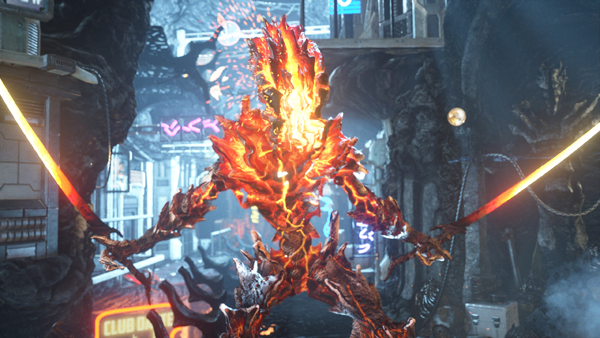

As we get into something a bit more intensive, we can see the Sapphire R9 285 2GB Dual-X OC performs well at both resolutions against both the R9 280 3GB and GTX 760 2GB. The difference against the R9 280 3GB isn't much, but in the end, it's a win at both presets.
Benchmarks - 3DMark Sky Diver & Catzilla
3DMark Sky Diver
Version and / or Patch Used: 1.1


3DMark Sky Diver is a benchmark that shifts the focus to mid-range video cards. Looking above, you can see it again manages to outperform the R9 280 3GB. This is good, although when it comes to the specification side of things, it really shouldn't come out ahead. Still, it's more expensive, and it's faster. That's what we want to see.
Catzilla
Version and / or Patch Used: 1.3


When we look at Catzilla, we can see that the performance of the Sapphire R9 285 2GB Dual-X OC is again great at the lower 1920 x 1080 resolution. When we crank it up to 2560 x 1600, though, you can see the overall score falls behind the cheaper card.
Benchmarks - Unigine Heaven & Phantasy Star Online 2
Unigine Heaven Benchmark
Version and / or Patch Used: 3
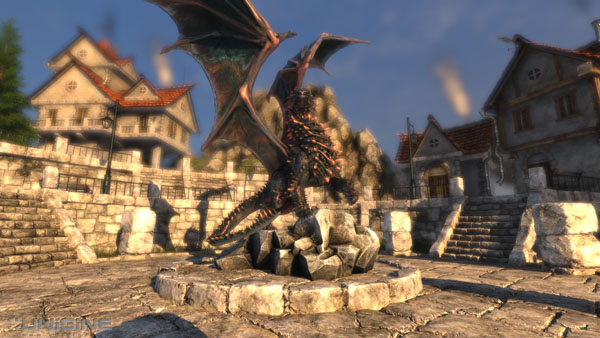

In a benchmark that normally favors NVIDIA cards, you can see the Sapphire R9 285 2GB Dual-X OC does a fantastic job with a win at both resolutions. Not only does it outperform the GTX 760, it also manages to outperform the R9 280 3GB.
Phantasy Star Online 2
Version and / or Patch Used: Standalone Benchmark


Starting to get into our real-world benchmarks, you can see that PSO2 performance again works well for the Sapphire R9 285 2GB Dual-X OC. You can see it sits above both the GTX 760 and R9 280 3GB.
Benchmarks - Lost Planet 2 & Just Cause 2
Lost Planet 2
Version and / or Patch Used: Standalone Benchmark

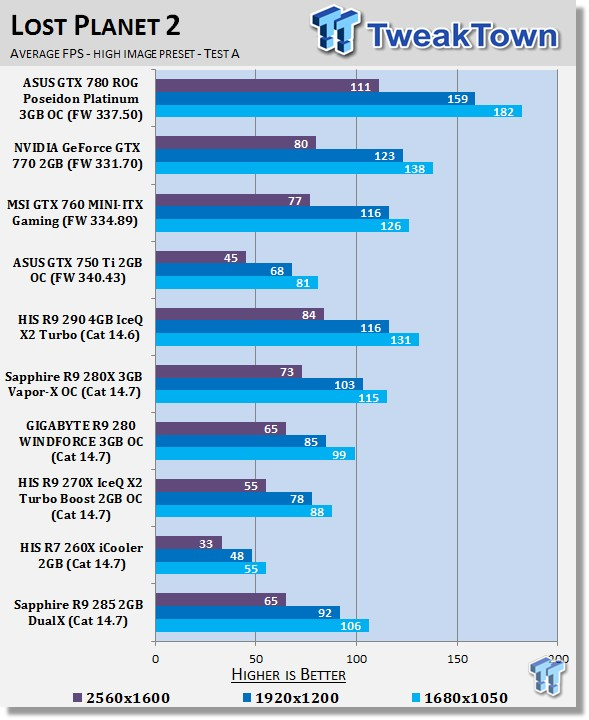
Taking a look at Lost Planet 2 performance, the GTX 760 has no problem coming out ahead in a benchmark that has always favored NVIDIA cards. You can also see the Sapphire R9 285 2GB Dual-X OC does manage to get playable FPS at all resolutions. Compared against the R9 280 3GB, you can see it's ahead at all resolutions. When we hit 2560 x 1600, though, you can see the gap closes between the two cards, with both scoring an even 65 FPS.
Just Cause 2
Version and / or Patch Used: Latest Steam Update


Taking a look at Just Cause 2 performance, you can see that the three main cards we're looking at are all on top of each other. All offer playable numbers at all resolutions with the two AMD offerings giving us the same 79 FPS average at 2560 x 1600. A strong increase over the 67 FPS seen from the GTX 760 2GB.
Benchmarks -Metro Last Light & Nexuiz
Metro Last Light
Version and / or Patch Used: Latest Steam Update


Metro Last Light numbers look good for the Sapphire R9 285 2GB Dual-X OC. Out of it, the R9 280 3GB, and the GTX 760, it's the only one to offer playable FPS at 1680 x 1050. It continues to hold the lead at the higher resolutions, but after 1680 x 1050, the number are no longer at a playable level.
Nexuiz
Version and / or Patch Used: Latest Steam Update


Nexuiz performance is a little funny. Looking above, you can Sapphire R9 285 2GB Dual-X OC falls behind the cheaper R9 280 3GB. We say it's funny, though, because while it lags behind, which ultimately isn't great for the model, it ultimately doesn't matter, as all three cards struggle to get playable numbers at any resolution anyway.
Benchmarks - Sniper Elite V2 & Sleeping Dogs
Sniper Elite V2
Version and / or Patch Used: Standalone Benchmark
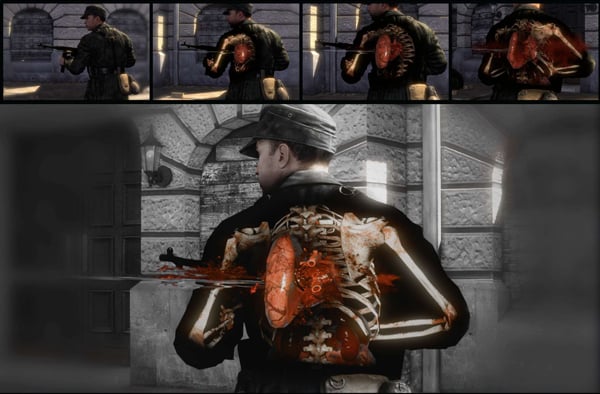

Sniper Elite V2 sees the Sapphire R9 285 2GB Dual-X OC and R9 280 3GB perform almost identically to each other. The GTX 760 2GB, on the other hand, comes out ahead at all resolutions. The big difference is that it also manages to pull in playable FPS at the highest resolutions, something the AMD cards can't do here.
Sleeping Dogs
Version and / or Patch Used: Latest Steam Update


Sleeping Dogs sees the Sapphire R9 285 2GB Dual-X OC get playable numbers at all resolutions and it comes out ahead of both the R9 280 3GB and GTX 760 2GB. Against the other two cards, it's a clear win for the new model.
Benchmarks - Hitman Absolution & Tomb Raider
Hitman Absolution
Version and / or Patch Used: Latest Steam Update
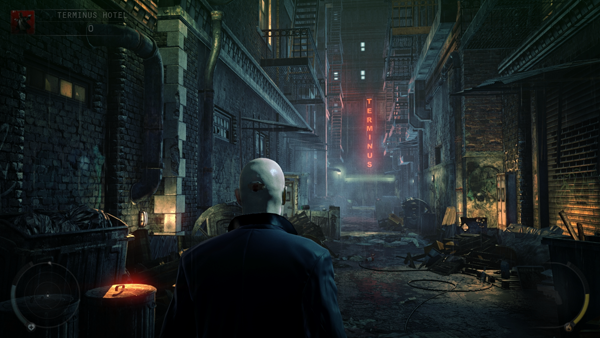

Hitman Absolution performance is solid across the board, and while we fall short of the 60 FPS number we want at the highest resolution, the 47 FPS minimum combined with the 59 FPS average means it's playable. The GTX 760, on the other hand, struggles at the highest resolution to give us number we want to see for a playable experience.
Tomb Raider
Version and / or Patch Used: Latest Steam Update
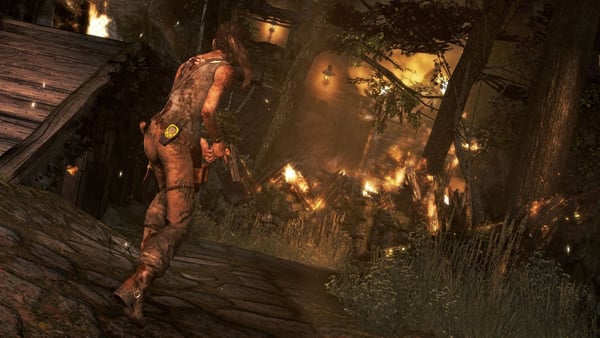

Looking at one of our most intensive benchmarks, you can see the Sapphire R9 285 2GB Dual-X OC actually falls behind the R9 280 3GB here. Both cards offer playable numbers at 1680 x 1050, while 1920 x 1200 is just passable thanks to the strong minimum. The GTX 760 is not a good option here as it falls a decent chunk behind both cards at all resolutions.
Benchmarks - BioShock Infinite & Battlefield 4
BioShock Infinite
Version and / or Patch Used: Latest Steam Update


BioShock Infinite sees some good numbers from the AMD offerings, and you can see the Sapphire R9 285 2GB Dual-X OC and R9 280 3GB sit almost on top of each other, again. While the GTX 760 manages to also offer playable numbers at 1920 x 1200 and 1680 x 1050, the extra breathing room coming from the AMD offerings is appreciated, as we move into the 70 FPS range.
Battlefield 4
Version and / or Patch Used: Latest Origin Update


When it comes to Battlefield 4, you can see the Sapphire R9 285 2GB Dual-X OC gets an easy win at all resolutions with playable numbers not being an issue. Enable Mantle on the AMD cards and you'll see even more performance.
Benchmarks - GRID Autosport
Grid Autosport
Version and / or Patch Used: Latest Steam Update
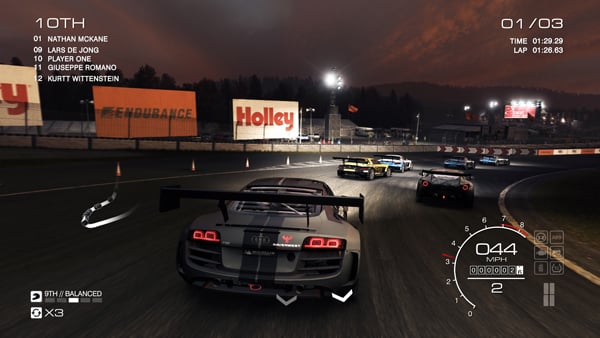

GRID Autosport sees some great performance out of the Sapphire R9 285 2GB Dual-X OC. At the highest resolution, though, while it's 10% up on the R9 280 3GB, we'd prefer a little bit more breathing room for a better gaming experience.
Benchmarks - High Quality AA and AF
High Quality AA and AF Testing
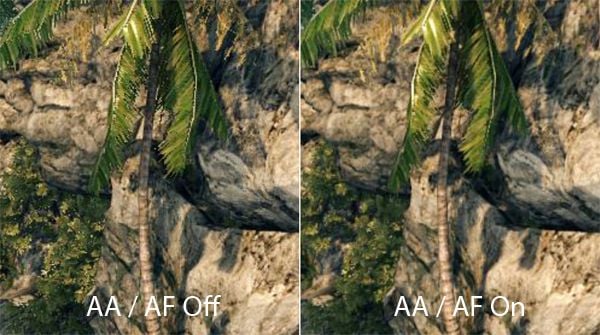
While we test all our games with maximum in-game settings, turning on Anti-Aliasing (AA) and Antistrophic Filtering (AF) helps take the intensity of our testing to another level.
Here we see video cards go from playable FPS to unplayable FPS and the real power houses continue to help break that 60 FPS mark we always aim for to provide a smooth gaming experience.

Turning on AA and AF, you can see all our setups plummet. While the Sapphire R9 285 does fall behind the cheaper R9 280 3GB here, the bottom line is that you can't game with these settings at all on any of these setups.

GRID Autosport sees the Sapphire R9 285 2GB Dual-X OC and R9 280 3GB perform close to each other. More importantly, though, we've got playable FPS at 1920 x 1200.

Just like we saw under Metro Last Light, the FPS just plummets. While the Sapphire R9 285 is ahead of the R9 280 3GB here, the numbers are just too low for it to really matter.
Benchmarks - 4K - 3840 x 2160 Testing
4K - 3840 x 2160 Testing

4K monitors are the next step for gamers demanding the best in image quality. With 4x the pixels of a standard 1920 x 1080 monitor (meaning 4x the intensity); 3840 x 2160 brings with it a new level of intensity to video cards.
Wanting to make sure that you're buying the right video card for a monitor that offers such a large resolution, we test the latest and greatest video cards in a couple of benchmarks to give you an idea of just what kind of setup you require.

Moving to 4K, the performance is good on the Sapphire R9 285 2GB Dual-X OC with it coming out ahead of the R9 280 3GB here.

While we again see that the Sapphire R9 285 2GB Dual-X OC comes out ahead of the R9 280 3GB here, the difference doesn't really matter, as the overall FPS is just too low.

While the numbers under Hitman Absolution are just too low overall, you can see the added memory bandwidth on the R9 280 3GB makes a big difference in the minimum department.

While again it doesn't really matter as all our setups aren't playable here, you can see that the added memory bandwidth on the R9 280 3GB is clearly helpful as the FPS difference between the setups is quite large.

Like our other results, while the FPS are just too low to game at, you can see the R9 280 3GB with its larger memory bandwidth has a clear win.
Temperature & Sound Testing
Temperature Test

The temperature of the core is pulled from MSI Afterburner with the max reading used after a completed run of 3DMark Vantage at the Performance preset.

The Dual-X cooler from Sapphire continues to do a good job. Looking above, you can see it's in the bottom half of the graph, with the core topping out at 65c under load.
Sound Test

Pulling out the TES 1350A Sound Level Meter, we find ourselves quickly yelling into the top of it to see how loud we can be.
After five minutes of that we get a bit more serious and place the device two CM away from the fan on the card to find the maximum noise level of the card when idle (2D mode) and in load (3D mode).

The temperature numbers are solid, but the noise levels are fantastic. Looking above, you can see that the Sapphire R9 285 2GB Dual-X OC sits near the bottom of the pack, just where you'd want to be in this test.
Power Consumption Testing

Using our PROVA Power Analyzer WM-01--or "Power Thingy" as it has quickly become known as to our readers--we are now able to find out what kind of power is being used by our test system and the associated video cards installed. Keep in mind that it tests the complete system (minus LCD monitor, which is plugged directly into AC wall socket).
There are a few important notes to remember, though. While our maximum power is taken in 3DMark06 at the same exact point, we have seen in particular tests the power being drawn as much as 10 percent more. We test at the exact same stage every time, so tests should be very consistent and accurate.
The other thing to remember is that our test system is bare minimum--only an SSD hard drive is used with a single CD ROM and minimal cooling fans.
So while the system might draw 400 watts in our test system, placing it into your own PC with a number of other items will result in a higher draw.

When it comes to power draw, you can see at just under 450 watts, the Sapphire R9 285 sits in the middle of the pack. For a setup like this, we'd recommend a quality power supply that sat at around the 650 watt mark.
Pricing, Availability, and Final Thoughts
AMD's Radeon R9 285 is actually ultimately a really strong video card and the Sapphire Dual-X variant of it is excellent. The Dual-X cooler does a great job as we see fantastic temperature and noise levels. I want to say nothing but good things about the card because I feel it's a great card. The price point is solid. The performance is really strong. The Sapphire R9 285 2GB Dual-X OC is just an overall great card.
It will unfortunately live or die by the AMD marketing and sales teams. The R9 285 name is terrible for a card that sits between the R9 270 Series and R9 280 Series. I'm not going to pretend that I could think of a better name, but I also have only been thinking about a new name for a day; and that is only while I was writing this review.
How does the R9 285 2GB go against its NVIDIA competition, the GeForce GTX 760? We'd say fantastically. If we compare those two cards only, it's the better buy. Clearly. No one could argue that. After this, the GTX 760 could really do with a bit of a price drop. The problem is the biggest competitor to the R9 285 2GB isn't the GTX 760.
For some unknown reason, AMD has made the biggest competitor to the R9 285 2GB the R9 280 3GB. If it wasn't for the fact that AMD made such a big push to us recently with the R9 280 3GB, then maybe we would think that they're going to phase the model out. If that's the case, this is perfect. Phase the R9 280 3GB out, let the R9 285 2GB come in. And although the name is extremely confusing, the price shows that it's under the R9 280X at least.
The big problem is that not only are we hearing that the R9 280 3GB isn't going anywhere, we're hearing that a ton of stock is floating around waiting to be sold. So, what's the better buy? Overall, we would say from a performance standpoint, the R9 285 2GB deserves to be more expensive, as it tends to win more often - especially at the resolutions it's aimed at. The only time the R9 280 3GB comes out ahead is at the highest resolution when the extra memory bandwidth comes in handy. The other thing that we have to mention is that the GIGABYTE version of the R9 280 3GB we have comes with a massive out of the box overclock. So, from that point of view, it shows the model in the best light.
The problem is that the R9 280 3GB isn't that much slower at times and it can actually be had for around $50 less, or 20%. Has AMD priced the R9 280 3GB too low now? Or are companies just simply dropping the price to dump the stock? I've been around in this game long enough to know this happens. If that's the case, it's hurting the R9 285.
We really have no need to compare the GTX 760 and R9 285. The results speak for themselves and the AMD card is just a better buy. The problem for the R9 285, though, is the R9 280 3GB and a pricing structure that is all over the place. There's a $70 - $80 price gap between the cheapest R9 280 3GB and the most expensive. That just goes to show how out of whack the pricing model is for this card. When the R9 280 3GB launched, I felt it was a misstep by AMD. Recently taking a look at four versions of the card again and seeing them at the new price point, I found myself impressed with what the card had become. Release the R9 285, though, and the R9 280 3GB is AGAIN looking like another misstep by AMD.
In the end, AMD are glad that your decision is between one AMD card or another and not one AMD card and an NVIDIA one. The problem is you've got an army of salespeople that honestly can't be bothered explaining the naming scheme to customers. AMD has packed the $200 - $300 price bracket so tight that they're just confusing people. It's obvious that even they don't know 100% where to put the R9 280 3GB as it's left out of the main AMD PowerPoint presentation.
Like we said in the beginning, this card is going to live or die by its marketing, and unfortunately, I feel it's going to be the latter. For years, we constantly hear how AMD are finally getting everything together. This time it's different. Everything is going to change now. Maybe in the end it does change, but the end result is the same. AMD marketing continue to run into problems. There is miscommunication on some level, or something that's not going right.
You might sit here thinking that I must really hate AMD. But it's the complete opposite. I have a ton of respect for this company and the products they make. It's that reason I find myself getting so annoyed by the way the company handles certain things. The latest crop of AMD APUs? We heard nothing about them. If they finally do send, it comes so late that it doesn't matter anymore. We work on the internet and live in the tech industry. Everything has to happen 10 minutes before. Not 10 minutes after.
I like AMD products. I use an AMD based video card in my current system and will be using them in my future one. But the R9 285 2GB is just another mishandling by AMD when it comes to executing a product launch. Someone at AMD is making the marketing team's job harder than it has to be. The problem is that it could well be the marketing team itself.
The R9 280 3GB should've never existed. It ruined the mid-range line up from AMD. Thanks to a terrible pricing structure, it simply just confused everyone. The R9 285 should've been able to get the R9 280 name. People don't like to be confused. If you're reading this, you're lucky. You're not one of those people that will walk into a computer shop and ask the sales guy you want a video card for $250 and then deal with a salesperson who is just going to sell you the easiest product. Instead, you're the person who's going to go in and say, "I want that R9 285", and when the guys says, you know the R9 280 is cheaper, or the GTX 760 is cheaper, you can say, "no, I know what I want!".
The good news is that you the consumer end up with a ton of choice. Maybe at times too much, but a ton of choice nonetheless. The people who really suffer are the AMD partners and distributors who now have to call up the retail channel and explain to them that they should buy the R9 285 because while it's better than the R9 280, it's not as good as the R9 280X.


 United
States: Find other tech and computer products like this
over at
United
States: Find other tech and computer products like this
over at  United
Kingdom: Find other tech and computer products like this
over at
United
Kingdom: Find other tech and computer products like this
over at  Australia:
Find other tech and computer products like this over at
Australia:
Find other tech and computer products like this over at  Canada:
Find other tech and computer products like this over at
Canada:
Find other tech and computer products like this over at  Deutschland:
Finde andere Technik- und Computerprodukte wie dieses auf
Deutschland:
Finde andere Technik- und Computerprodukte wie dieses auf